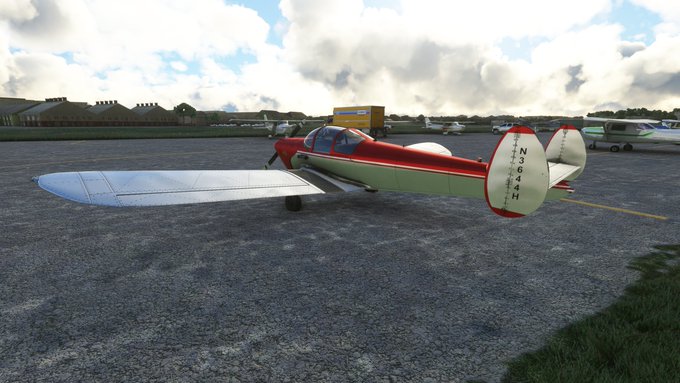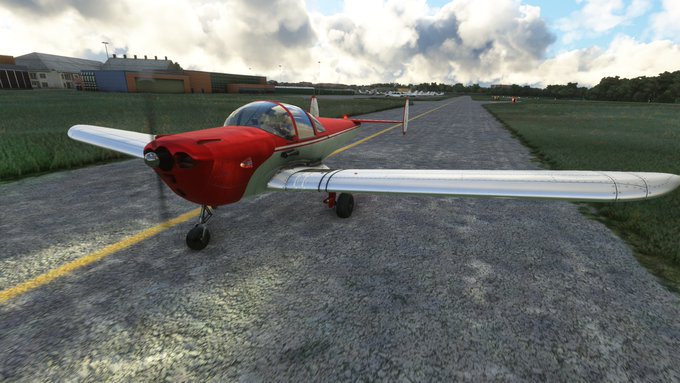December 13, 2022
Today on Microsoft Flight Simulator, I’m flying a rather unusual airplane developed just before World War II, which aimed to make flying as easy as driving a car: the ERCO Ercoupe 415C.

What’s so odd about it? It’s easy to miss. No rudder pedals.

To understand why the Ercoupe has no rudder pedals, and was sold as “the world’s safest plane”, I have to explain stalls and spins.

A “stall” doesn’t refer to the engine going out. It’s when an airplane’s wing is positioned at too high an angle to the airflow, causing it to stop producing lift. Stall your wings and they will no longer fly, and you’ll start dropping towards the ground.

A “spin” develops when one wing stalls before the other, causing it to drop and pull the airplane into a spiral. A lot of accidents are caused when the airplane gets into a spin and can’t recover before hitting the ground.

In the 1930s, engineer Fred Weick was tasked by the National Advisory Committee for Aeronautics (NACA) with researching the development of an airplane designed not to spin.

The immediate product of that research was the Weick W-1. In addition to being spin-proof, it also featured “tricycle” landing gear that, by leaning forward on a nose-wheel, avoided ground loops on landing that were a hazard with the tailwheel airplanes common at the time.

In 1936, Weick left NACA to join Engineering and Research Corporation (ERCO) to commercialize his innovative airplane designs.

ERCO was based in Riverdale, Maryland, next to College Park Airport where I’m parked now, just outside of Washington, DC.

Weick refined his designs into the Ercoupe (pronounced “ur” nor “air”) which first flew in 1939 and went on sale the following year.

The fuselage was constructed of light-weight aluminum, a groundbreaker for its time. The wings were originally covered in fabric but later, like this one, with metal sheets.

The powerplant was a 75 horsepower Continental 4-cylinder air-cooled piston engine.

Of course, the most striking feature of the Ercoupe is that it has no rudder pedals, only a yoke.

The yoke is linked not only to the ailerons, on the wings, but also to the rudders on the tail fins. Turn one and you turn the other. The idea is to keep them coordinated, thus preventing the possibility of a spin.

In his classic book “Stick and Rudder”, published in 1944, Wolfgang Langewiesche repeatedly declares that he expects separate rudder controls to become a thing of the past. That didn’t happen, but I can only imagine he must have had the Ercoupe in mind.
Initially, Weick designed the Ercoupe with a single tail fin, but redesigned it to twin tail fins to avoid the spiraling slipstream from the propeller that tends to hit a single tail fin and push the nose to the left on takeoff.

The upward movement of the elevator is limited to make stalling the Ercoupe all but impossible.

Rather than a pitot tube (like on the Cessna 172) the Ercoupe has a venturi meter (the black device that looks like an old automobile horn) to deliver air pressure to the airspeed indicator.

Notice that there are no flaps, and the ailerons extend the full length of the trailing edge of the wings, making the airplane very responsive.

Taxiing is a weird experience. I’m used to steering the nose wheel with the foot pedals – and kept trying to do so, out of habit. Instead, with the Ercoupe you use the yoke as a steering wheel, like a car.

In the sim, I reset the controls to disconnect the rudder pedals (except for braking) and make the yoke control the ailerons and rudder at the same time. It worked ok for steering on the ground.

But when I tried to take off, it was very hard to maintain directional control (with the rudders) without tipping the airplane over with the ailerons as the wings started to gain lift. I’m not sure the flight model in MSFS is really attuned to the Ercoupe’s unique controls.

I did get off the ground, but it was a pretty wild ride. I don’t think it would have been a problem, in the sim, if I kept the rudder and aileron controls separate.

The market for the Ercoupe almost immediately evaporated because of the onset of World War II. So did the supply of aluminum to make it.

The US military did use a few models to test rocket-assisted takeoffs, but otherwise the Ercoupe found no use during the war.

But immediately after the war’s end, the Ercoupe found an eager retail audience among pilots returning from military service and a public fascinated by wartime aviation.

It was sold as a safe, easy-to-fly improvement on the family car – the wave of the future.

The Ercoupe was even sold via department stores like Macy’s, Wannamaker’s, and Marshall Field’s. It could be purchased on installment for $3,150 – the average annual income at the time, and about twice the price of a car.

Sales took off, with over 4,000 Ercoupes sold in 1946.

Production at the tiny ERCO plant in Riverdale, just outside of DC, surged to 35 Ercoupes per day, aiming at 50.

Promotional photo of an Ercoupe flying over Washington, DC, back when you could do that sort of thing and not get intercepted by fighter jets.

But hey, nothing’s stopping me from doing that in the sim, right?

The post-war boom didn’t last, though, and by the end of 1946, inventories of unsold Ercoupes were piling up on the factory lot.

One major problem: ERCO ran into a lot of obstacles expanding the design – making a 4-seat instead of 2-seat model, for instance, or putting the Ercoupe on floats – while still getting certified as spin-proof.

And if it wasn’t spin-proof, then the tiny Ercoupe didn’t really have a lot of advantages over more versatile aircraft like the Piper Cub or the coming Cessnas and Bonanzas.

Still, a lot of people enjoyed the Ercoupe because it was easy to learn (an average of just 4 hours to solo), and it continued to be produced, under different brands and formats, until 1969.

Before I land, I’m going to tell one very interesting, and very inspiring, story about the Ercoupe and a pilot named Jessica Cox, who you can find on Twitter. @jess_feet

Jessica was born with no arms, but learned to do an amazing number of things using her feet.

She wanted to learn to fly, but most airplanes require the use of foot pedals to control the rudder, as well as arms to control the yoke and throttle.

But with a rudder linked to yoke, the Ercoupe left Jessica free to use her feet – as she was used to doing – to take the place of arms and fly the plane.

In 2008, Jessica became the first person without arms to earn a pilot’s license. You can see more about her amazing story here.
I still have to land this thing in the sim. With no flaps, I found it awfully difficult to slow down enough, especially to land on a relatively short runway back at College Park.

Plus, the flight model is so screwy with the linked controls that there were, shall we say, mishaps. This wasn’t helped by the fact that the brakes seem very underpowered. After landing, it just kept going!

Fred Weick went on to teach at Texas A&M, where he designed the Ag-1 cropduster, a design much imitated which you might recognize as the model for Dusty Crophopper in the movie “Planes”.

I did another post on a descendant of the Ag-1 in Brazil, the Embraer EMB200 Ipanema.

Weick later went on, in 1957, to join Piper Aircraft as its chief development engineer, where he co-designed the PA-28 Cherokee, one of the most popular low-wing alternatives to the Cessna 172 for training. He passed away in 1993.

As its advantages became obvious, the steerable tricycle landing gear that was so innovative on the Ercoupe was increasingly adopted during World War II, and is now standard on most airplanes worldwide.



The linked aileron and rudder controls did not. My experience with the Ercoupe in the sim makes me very curious how it handles in real life. Maybe someday I’ll get a chance to find out. In the meantime, hope you enjoyed.

Leave a Reply